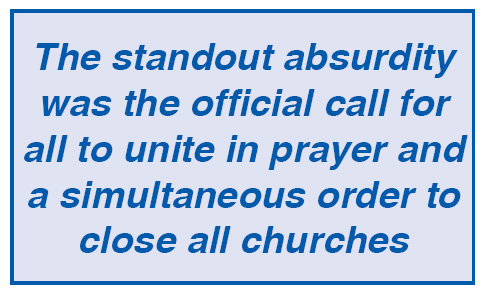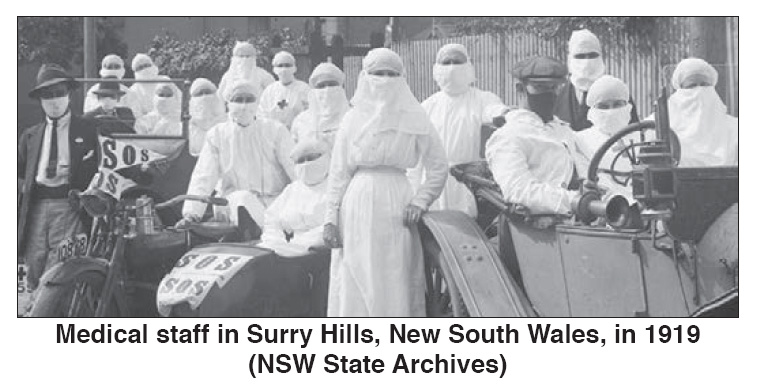A tale of two pandemics: Spanish influenza and Wuhan flu by John Morrissey
"The only thing that we learn from history is that we
learn nothing from history"
— Georg Hegel (1770–1831), German philosopher
After the fear cultivated among Australians, the shambolic and shameful behaviour of some state premiers, and the damage done to the Federation over the past two years, it is instructive to look at the way our forebears faced a similar challenge a century ago. It was in 1918 when a young Australia experienced the so-called Spanish influenza, an avian virus which may have mutated from the common flu and surfaced on the Western Front with the arrival of millions of U.S. troops in 1918. The misnomer resulted from the Spanish king being its first notable victim. It is thought to have taken 30 million lives across the globe, including perhaps 12,000 out of Australia's population of fewer than five millions.
The first sign was a severe chill or shivering fit, followed by
an acute headache and pains spreading from the back. Vomiting
and diarrhoea, running eyes and nose, and a sore coughing throat
were common symptoms, and sometimes
the skin assumed a bluish tinge. Pneumonia was a frequent complication, and those
with heart or chest conditions risked death.
was a frequent complication, and those
with heart or chest conditions risked death.
Medical opinions and methods of treatment were diverse: sweating powders, mustard plasters, inhalations, hot baths, better diet, fresh air and many more. On Salisbury Plain in England, Australian Imperial Force (AIF) troops awaiting repatriation were subjected to route marches and gargling Condy's crystals (potassium permanganate) in salt water twice daily.
Doctors were scarce in Australia at the time, and often elderly, owing to so many of them still serving overseas. In any case they were distrusted by many, seen as akin to police spies, as they were required to notify the authorities of any cases of venereal disease, which involved extremely painful treatment. A century later, it is hard to distinguish responsible medical practice then from quackery; but it is worth recalling that Dr Morse's Indian Root Pills, a North American herbal patent medicine which purported to help "cleanse the blood" of disease-causing impurities, enjoyed stellar sales in Australia during the pandemic.
Then, as today, the Commonwealth government led the way, being responsible for quarantine, which was focused on ship arrivals and relied on stations, such as the Victorian facility at Point Nepean. As early as October 1918, ships which had docked at South African or New Zealand ports were quarantined for seven days, and 300 cases of the pandemic influenza had been treated at Sydney stations, with numerous deaths, before the virus spread to the general population.
Most arrivals of course were homecoming troops, and there were frequent cases among them, as well as deaths during the voyage. Passengers and crews of ships without record of infection were nevertheless subjected to zinc sulphate inhalations and daily "thermometer parades", while even one infected person aboard a vessel would result in inoculations for all and compulsory facemasks for the period of quarantine.
The records make much mention of inoculations, and it seems that the vaccines were prepared from the sputum of pandemic victims. However, there was considerable distrust of the needle. This was fed by deaths occurring from occasional bad batches. Although by the end of 1919 a quarter of the New South Wales population had received two doses, this general distrust of the needle was already reflected in the 607 deaths in Australia in 1918 from diphtheria, long since preventable by then with free injections.
Initial confidence in securing immunity for Australia evaporated in 1919 as the disease spread among the resident population. Evidence exists of medical officers on troop ships falsifying their records to avoid protracted quarantine for returning Diggers, after perhaps four years of war. There were even break-outs from quarantine, such as the 1,000 men who abandoned the unprepared and snake-infested camp at North Head, Sydney, where they had been landed. Family re-unions and victory parades were postponed or cancelled, souring the mood of the population.
Commonwealth and state relations deteriorated rapidly. In November 1918 a meeting of state health ministers, Australian branch presidents of the then British Medical Association and the Commonwealth Minister for Trade and Customs adopted a plan of action. This included closure of state borders where the Commonwealth proclaimed a neighbouring state infected, on the notification of its Chief Health Officer. Of course this came unstuck when Victoria failed to notify an infection for a fortnight — until NSW had notified its first person infected, who had in fact just arrived from Victoria! Thereafter it was every state for itself. Sound familiar?
As with today, the authority of the Commonwealth was
flouted. Such sentiments peaked in Western Australia, where
the transcontinental train was impounded and the Kalgoorlie
district health officer inquired whether he should quarantine
the passengers' excreta as well! Queensland applied to prevent
repatriated troops being landed at a mainland quarantine station,
and broke the November conference agreement by refusing free access to persons living only ten miles from its border.
access to persons living only ten miles from its border.
Crossings were restricted to Wallangarra, at a cost of 12/6 per day of detention, two injections and thrice daily stints in an inhalation chamber. Conditions were abominable and only intercession by the Anglican archbishop secured separate toilets for ladies. Conditions were no better in South Australian camps, for which the state government took no responsibility. With the exception of NSW leaders, our present-day state premiers like Annastacia Palaszczuk would have fitted in very well.
In the community itself there was a particular division of opinion over wearing masks, which were enforced in NSW. Some saw them as breeding grounds for infection or as sapping the "vital force" of the population. A Bovril advertisement compared their effectiveness to using barbed wire fences to shut out flies. However, the Director of Quarantine defended them because they reassured nervous persons and provided an indication that precautions were being taken. We would recognise such a rationale as similar to the thinking of governments during the present pandemic.
Other public health measures rivalled the inanities of the current Victorian government, with its inconsistent regulations from Day One, including the sanctioned Black Lives Matter march, the later sealing off children's playgrounds with "crime tape", and then opening up golf courses, but not their toilet facilities.
In NSW in 1919, libraries, theatres, schools and places of indoor entertainment were closed, and then racecourses and hotels. Relaxations followed, but an order prohibited hotel bar patrons from remaining on the premises for more than five minutes! Perhaps the standout absurdity was the official call for all to unite in prayer and a simultaneous order to close all churches. A subsequent compromise allowed open-air prayer for masked congregations — observing social distancing and lasting no more than 30 minutes.
Australia experienced much lower death rates from the Spanish influenza then even England and New Zealand; but in 1919 the Commonwealth Year Book recorded a 25 per cent increase over preceding years in the overall death rate. As with today, the lives of those with pre-existing heart and chest problems were shortened. Mortality was abnormally high among males in the 25–40 age group. It is also interesting to learn that the death rate was highest in NSW, where the compulsive measures of the state government were most extensive.
Fear played a part in the responses of governments and people during those years, but it does not seem to have been as pronounced as it is today. In spite of the medical knowledge at that time being insufficient to meet the challenge of the pandemic, there was confidence in the "characteristic Australian spirit", as the popular Lone Hand magazine put it. The Medical Journal of Australia called for "proportion", and there was hope and gratitude that things were so much better here than abroad. This journal also accused the daily papers of "fanning the flame of panic". Other issues, such as the rise of Bolshevism and fear of its spread in Australia, also engaged public opinion.
It remains to ask ourselves why there is such disproportionate fear today in Australia, when medical knowledge and resources are so much better equipped and the Federal government's support has been so generous. Widespread testing and state governments' daily announcement of (largely asymptomatic) case numbers, rather than hospitalisations and actual deaths, have stoked the fears and been used to justify socially and economically destructive lockdowns. On top of print media, electronic and social media have focused on little else for nearly two years.
In contrast with the Australia of 1919–21, we have largely insulated ourselves from death and lost a sense of proportion. Our ancestors were emerging from a war which had taken 60,000 lives and maimed many more. Furthermore, deaths today rarely occur in the home, and life expectancy is 15 years greater. We have also grown up with the expectation that modern medicine and the welfare state will provide all the answers.
Finally, we no longer live in an age of religious faith in an afterlife, with the comfort of our churches and an eternal reward for us and our loved ones, as confirmed at funerals and gravesides. "Death where is thy sting?" puts it all into perspective.
For much of the information herein I am indebted to a paper delivered by Humphrey McQueen at the 45th Australian and New Zealand Association for the Advancement of Science (ANZAAS) Congress, held in Perth in August 1973.
John Morrissey is a retired secondary school teacher who has
taught in government, independent and Catholic schools. He
lives in the Melbourne suburb of Hawthorn.
![]()

